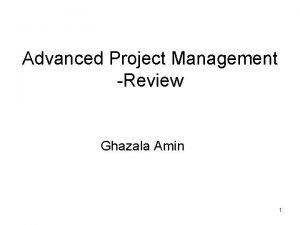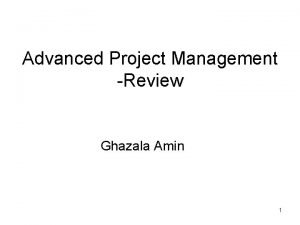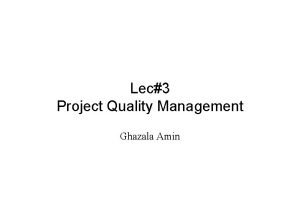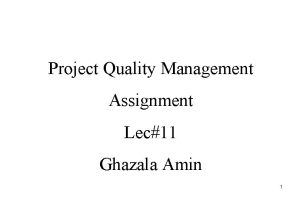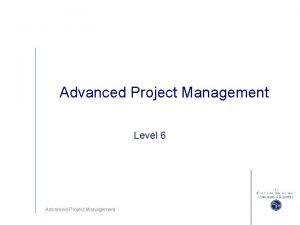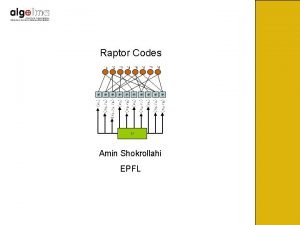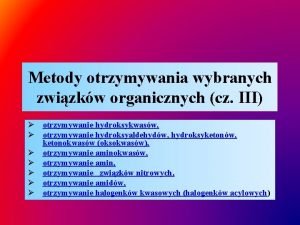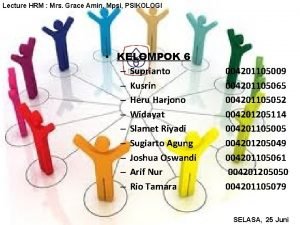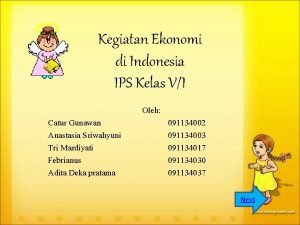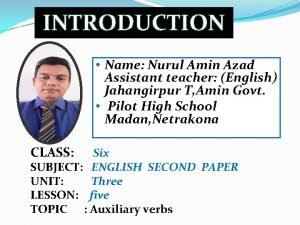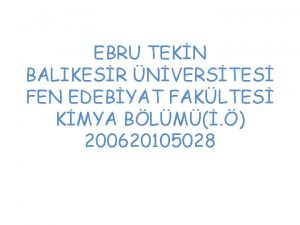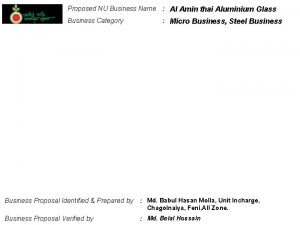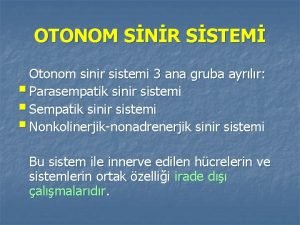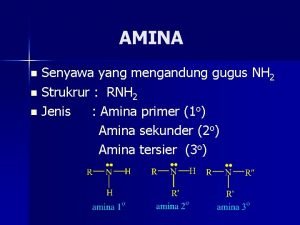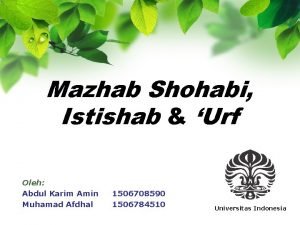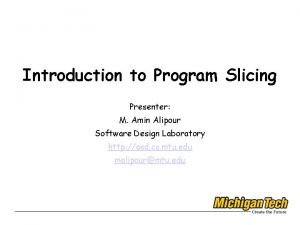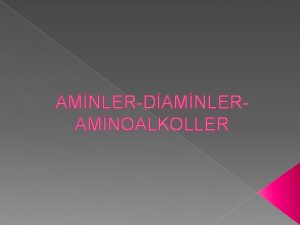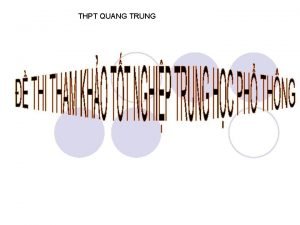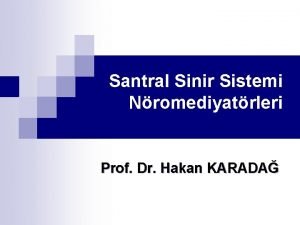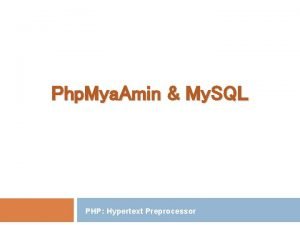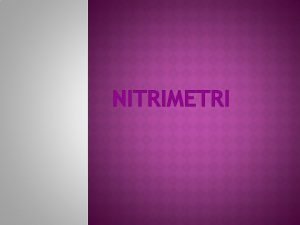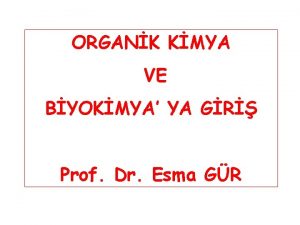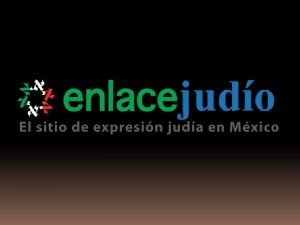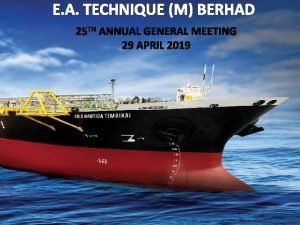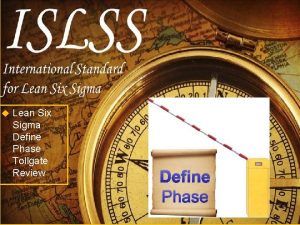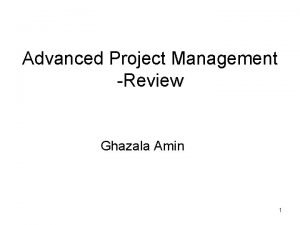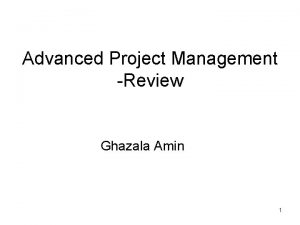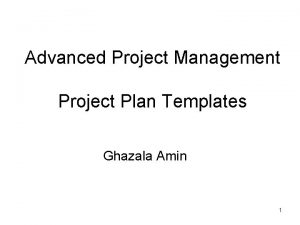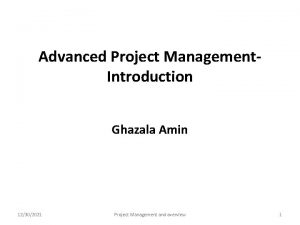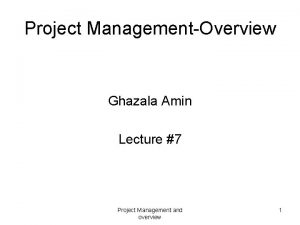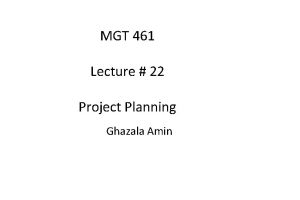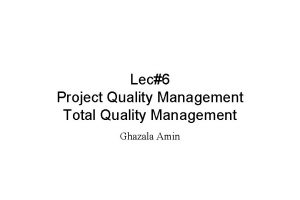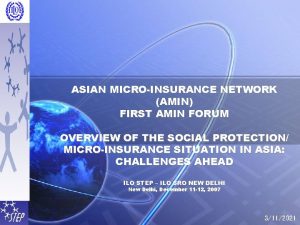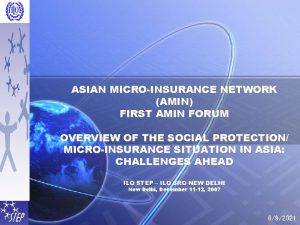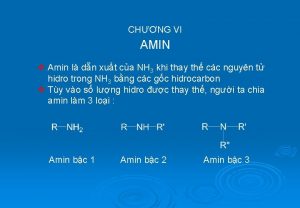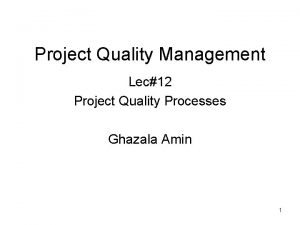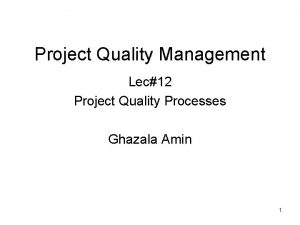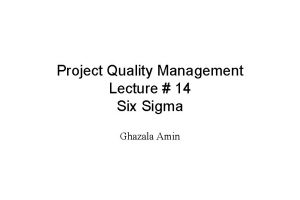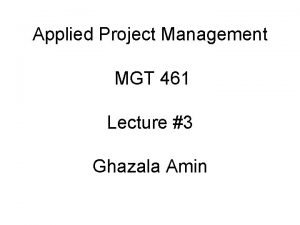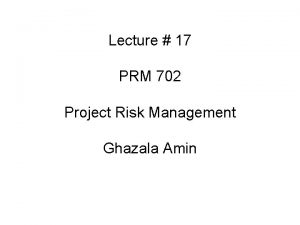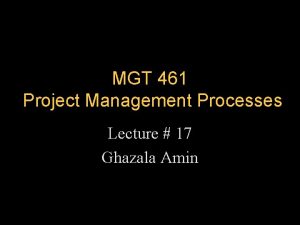Advanced Project Management Review Ghazala Amin 1 Project




































- Slides: 36

Advanced Project Management -Review Ghazala Amin 1

Project Management Knowledge Areas (PMBOK) The 9 PMBOK Areas & 5 Process Groups Integration Management Scope Management Time Management Cost Management Quality Management Human Resource Management Communication Management Risk Management Initiation 42 P R O C E S S E S Planning Implementation/ Execution Monitoring, Evaluation & Control Closure Procurement Management


42 processes 9 Knowledge Areas 5 Process Groups 4

Project Management Processes » PM processes are divided into five phases or process groups Initiating Processes Planning Processes Controlling Processes Professional Responsibility Executing Processes Closing Processes 5

Project Planning • • The purpose of Project Planning is to; establish and maintain plans that define project activities. Majority of Project Manager’s time is spent to effectively plan the project activities. 6

When Project Planning is not done well…. • Poor estimates lead to cost and schedule over runs. • Inability to discover deviations from undocumented plans • Resources are not available or applied when needed. • Inability to meet commitments • No lessons learned for future projects means making the same mistakes on multiple projects. 2004 -2005 by Carnegie Mellon University Introduction to CMMI V 1. 1 7 • PROJECTS FAIL; “IF YOU FAIL TO PLAN,

8

Project Planning Goals • Establish Estimates • Estimates of project planning parameters are established and maintained. • Develop a Project Plan • A project plan is established and maintained as basis for managing the project. • Obtain Commitment to the Plan • Commitments from relevant stakeholders are established and maintained. 2004 -2005 by Carnegie Mellon University Introduction tpo CMMI V 1. 1 9

Project Planning Context Establish Estimates Planning Data Obtain Commitment to the plan Develop a Project Plan Relevant Stakeholders 2004 -2005 by Carnegie Mellon University Introduction tpo CMMI V 1. 1 PM&C 10

How does an estimate become a budget • Validate estimate with the project team • Review assumptions, hours, risks etc. • Validate estimate with the sponsors, financial executive, quality assurance team. . • Business rationale, timings and cost estimates, any cost buffers or contingency reserves, profit contribution… • Baseline the budget • Report monthly status. • Plan what the senior management would like to see 11

Project Management Plan » Uses outputs from other planning processes to create a consistent and coherent document that can be used to guide both project execution and project control. » Formal, approved document used to manage and control project execution. » Project plan must be revised, reviewed, and revisited throughout the project and used as the axis around which all subsequent communications revolve. 12

» The formal Project plan includes but is not Project Plan limited the following documents. � Project Charter (Signed and completed in the Initiation phase) � WBS - Task and resource assignment � Major milestones and baseline target delivery dates � Project Communication Plan � Responsibility Assignment Matrix � Risk Management document � Issues Management document � Change Management document � Milestone Chart � Project Status Plan template � Quality Assurance document � Lessons Learned » The above documents need to be in place to be ready to execute, manage and track project performance. 13

Work Breakdown Structure • The WBS serves as the framework on which project is built and as the “map” for project execution. • WBS focuses attention on project objectives and encourages detailed planning and documentation. • It clarifies responsibilities and identifies elements for estimating and work assignment. • WBS is used throughout the project; it needs to be revised in event of any changes or updates. • WBS is the cornerstone of quality project planning!! � Source/Reference: IBM Learning Centre for development of PM Curriculum 14

Developing WBS • Gather all project-related materials that define solution, approach and scope. • Review WBS for similar projects • Prepare a hi-level WBS representing “WHAT” • Refine and decompose to manageable and track-able level • Involve responsible project team members in developing WBS • Include project support elements such as PMIS, quality assurance • Avoid developing details before it is needed • Review structure with responsible stakeholders; get buy-in from those responsible for deliverables • Add appropriate elements to manage risk • USE GOOD JUDGEMENT-THERE ARE NO HARD AND FAST RULES � Source/Reference: IBM Learning Centre for development of PM Curriculum 15

Set of Templates include • • • Project Charter Document Project Communication Plan Responsibility Assignment Matrix Risk Management Document Issues Management Document Change Management Document Milestone Chart Template Project Status Plan template Lessons Learned Report 16

Project Charter • A document that formally authorizes a project or phase and documenting initial requirements that satisfy stakeholders’ needs and expectations. • Project Sponsor signs the charter so the project could go in planning phase • We have developed a general project charter template which can be customized 17

Project Communication Plan • Many experts say that the greatest threat to the success of any project is a failure to communicate. • Project Plan itself is the most meaningful communication vehicle in the entire arsenal. • Communication Plan should be a comprehensive plan. 18

Responsibility Assignment Matrix (RAM) • A matrix that maps the work of the project as described in the WBS to the people responsible for performing the work as organizational breakdown structure. • RAM is very important document so the project staff is clear about their roles and responsibilities. 19

Risk Management Document • Risk: An uncertainty that can have a positive or negative effect on meeting project objectives. • Risk Management Plan: A plan that documents the procedures for managing risks throughout a project. • Risk Register is a document that contains results of various risk management processes, often displayed in a table or spreadsheet format. • A tool for documenting potential risk events and related information. 20

Issues Management Document • Issue: A matter under question or dispute that could impede project success. • When Risk occurs it becomes an issue. • Issue Management Template, documents all issues and how they should be resolved. 21

Change Management Document • When issues cannot be dealt with, they become changes. • Change management is very important for the project and it should be done through change control board • Change Management Document is supported by Change Request Form(s) to formally make changes in the project. • Change Request Log should be updated whether change request is approved or rejected. 22

Milestone Template • Milestone is a significant event on a project with zero duration. • We have designed milestone chart as certain activities need to be completed to move on to the next phase. • Milestones serve as a marker to help in identifying necessary activities, setting schedule goals and monitoring progress. 23

Project Status Plan Template • It describes where the project stands at a specific point in time. • Project Status is generated periodically depending upon the length of the project as per requirement. 24

Lessons Learned Report • Reflective statements written by project managers and their team members to document important things they have learned from working on the project. • It is a best practice to document the lessons learned on periodic basis. 25

Project Planning • The purpose of good Project Planning is to ensure; • All detailed plans for managing the project are defined • Formal commitments are established • Team is ready to execute !!! Effective project planning = readiness for performance. 26

Project Planning Checkpoint • • • As a project manager you must; Validate financial commitment to the business Set expectation with client and project sponsor Recognize that this is hard go/no go decision Have your project team committed to the plan Be ready to be accountable for the project execution Project Planning is crucial point in the project life cycle when you decide if the project is ready to commit to future execution tasks 27

Remember !! • Project Managers are responsible for; • • • Cost Project Profit Project team efficiency Project expenses Quality control ……………. At the end of the project planning process, your business executives decide if your project can/should target meeting specific business objectives. 28

Few Causes of troubled projects (Planning Phase) • Failure to set and manage customer expectations • Customer unprepared to take on project responsibilities • Lack of common understanding of requirements • Poor quality proposals • Lack of information in charter • Unclear organization roles and responsibilities • Failure to plan and manage project risks • Lack of defined quality control mechanisms • Inaccurate and uncommitted project estimates …. . 29

Project Management Processes » PM processes are divided into five phases or process groups Initiating Processes Planning Processes Controlling Processes Professional Responsibility Executing Processes Closing Processes 30

Project Management Processes » PM processes are divided into five phases or process groups Initiating Processes Planning Processes Controlling Processes Professional Responsibility Executing Processes Closing Processes 31

Project Closure • Consists of documenting project results to formalize acceptance of the product of the project by the project sponsor or the customer • Includes; – Lessons learned – Historical archives – Customer or End User Sign Off – Team appraisals etc…. . 32

Project Closure • Project Closure may result from; – Project Completion as agreed by the sponsor. • All project activities and work is complete. – Mutual agreement to close out the project. • lack of funds, change in policy etc. – Either party does not want to proceed further • Breach of Contract, legal proceedings, law suits etc. 33

Why we need Project Closure? • The purpose of Project Closure is to ensure; • • • project is formally accepted or terminated Contractual obligations are met Project records are completed, saved and archived Essential documentation is retained Resources (3 M-Man, machine, material) are released • Finance books are complete • Project Close out plan and it’s activities are part of the WBS tasks and resources should be committed to ensure successful closure. If you don’t start thinking of closeout from the beginning then you will not be able to close out at the end. 34

Project Closure Activities • • • Project plan updates complete Documentation Archived Legal Contract Closure Administrative Closure for Resources Team appraisal with development suggestions Positive team closure Corrective actions Lessons learned Sponsor and end user sign off document 35

Project Manager Closure Responsibilities • Completion of project documentation • Completeness of tasks • All terms of agreement • Releasing technical environment • Transfer assets • Transfer warranty and maintenance support • Secure intellectual capital • Include methods and processes developed • Products developed during the project • Prepare project evaluation report • Document and communicate lessons learned to management • Performance reviews submitted to the functional managers 36
 Ghazala amin
Ghazala amin Ghazala amin
Ghazala amin Ghazala amin wikipedia
Ghazala amin wikipedia Ghazala amin
Ghazala amin Project context
Project context Introduction to software project management
Introduction to software project management Raptor
Raptor Otrzymywanie hydroksykwasów
Otrzymywanie hydroksykwasów Grace amin
Grace amin Pak amin membeli beras di pasar termasuk kegiatan
Pak amin membeli beras di pasar termasuk kegiatan Mbbnonline
Mbbnonline Gabriel amin sentezi
Gabriel amin sentezi Amin thai
Amin thai Sentetik katekolaminler
Sentetik katekolaminler Appendectomia
Appendectomia Qasim amin
Qasim amin Etil metil propil amina
Etil metil propil amina Md nurul amin
Md nurul amin U ime oca i sina i duha svetoga molitva
U ime oca i sina i duha svetoga molitva Calvin sia
Calvin sia Apa itu istishab
Apa itu istishab Amin alipour
Amin alipour Kuaterner amin türevleri
Kuaterner amin türevleri đốt amin
đốt amin Amin yapılı nöromediyatörler
Amin yapılı nöromediyatörler Php my amin
Php my amin Reaksi diazotasi adalah…
Reaksi diazotasi adalah… Amin hossein rahimi
Amin hossein rahimi Jasmine amin chelsea
Jasmine amin chelsea Peyman milanfar
Peyman milanfar Nader amin-salehi
Nader amin-salehi 1-metilsiklopenten
1-metilsiklopenten Haj amin al-husseini quotes
Haj amin al-husseini quotes Amin rashidi
Amin rashidi Ea technique share price
Ea technique share price Tollgate process
Tollgate process Chapter review motion part a vocabulary review answer key
Chapter review motion part a vocabulary review answer key
